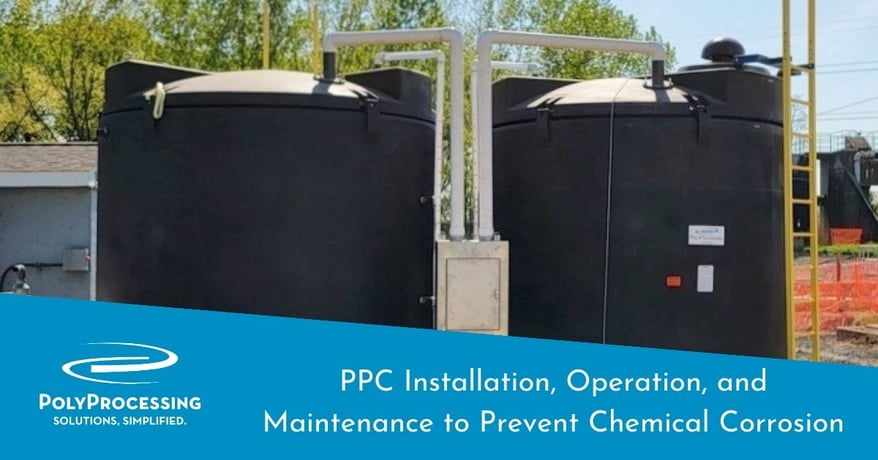PPC Installation, Operation, and Maintenance to Prevent Chemical Corrosion
Poly Processing works diligently to produce each and every chemical storage tank to spec. But if a tank isn’t installed correctly it could lead to chemical corrosion, causing damage, leaks, safety issues for personnel, and a shorter tank life. Everyone should take chemical tank installation seriously.

Our customers rely on our comprehensive Installation, Operation, and Maintenance Manual to help them properly install each of our chemical tanks, and their fittings and accessories. Whether it’s a standard vertical tank, IMFO® Tank, or a double-wall SAFE-Tank®, we’ve got you covered.
The PPC O&M Manual includes plenty of details and step-by-step instructions. The manual focuses on giving installers a simple, yet safe and effective way to correctly install and maintain a tank system for leak prevention.
Here are a few important highlights from the Operation and Maintenance Manual that are critical to understand and follow in order to prevent chemical corrosion and leaks. (Please read the IOM manual for more details and help.)
Tank Foundation and Site Preparation
When installing the IMFO® tank, only use a PPC polyethylene PolyBase, a polyurethane PolyBase or a monolithic concrete pad with finished edges to elevate the bottom of the tank above the primary floor surface. The pad must be at least 4 inches thick to provide full clearance for the IMFO® flange.
Use a polyurethane PolyBase or a concrete pad when storing fluids with a specific gravity greater than 1.65.
General guidelines to accommodate restraint clips and ladders:
- Make sure the foundation is at least two feet larger in diameter than the diameter of the tank. (Contact us for your specific application)
- If using the IMFO tank, notch the foundation to accommodate the IMFO outlet. Make sure the IMFO neck is supported and there are no valves or heavy piping hanging off the IMFO.
- If the tank will have a fixed ladder, include adequate landing for the ladder to prevent injury.
Flexible Connections
Fittings and connecting pipes installed on the lower third of the sidewall of a tank must have flexible connections with the lowest spring rates possible. This mitigates nozzle loading and allows the tank to expand and contract while protecting the tank from pump vibrations.
Pipe supports must be placed AFTER the flexible connection so the tank can properly expand and contract.
Pipes connecting to dome fittings should also be independently supported to eliminate nozzle load. Domes don’t require flexible connections, since there is little to no movement on the tank dome when the tank is filled and emptied.
Expansion joints should not be attached directly to the tank wall or IMFO®. A full-faced flange must be installed on the tank first.
Offloading a Tank
We’ve added instructions to help you safely offload your polyethylene chemical tank from the freight truck. You can choose from several methods, including a crane or a forklift. Poly Processing Company strongly recommends all tank lifting, movement, etc. be performed by professional certified riggers. Riggers are skilled at attaching or detaching lifting equipment to loads or lifting devices.
Proper Venting
Polyethylene tanks are designed and rated for atmospheric pressure only. Proper venting alleviates pressure and prevents a vacuum from developing as the tank is filled and emptied. The PPC O&M Manual provides configuration information and points to detailed venting guidelines for your chemical tank.
Vital Checklists
Once you’ve successfully installed your liquid storage tank, follow the helpful checklists we’ve provided to ensure that you get the most out of your tank and extend its useful life as long as possible. These preventive maintenance instructions are simple and easy to follow.
The procedures include:
- Startup Checklist
- Maintenance Checklist
- Annual Inspection and safety guidelines
- Warranty Information
Other Considerations and Precautions
It’s common to store tanks for a period of time before installation. Often, loose or boxed parts are misplaced or used for something else on site. We recommend clearly marking any loose boxes and parts for the chemical storage tank only. Store the boxes in a safe location where they can be easily found and retrieved.
- Tanks can sit in direct sunlight but a tarp or cover will help to keep them clean.
- Store tanks out of traffic areas, including forklift traffic, so they don’t get gouged.
- IMFO Tanks or Sloped Bottom IMFO Tanks need a 4 x 4 or other block under the tank so the flange isn’t pressed against the ground.
As always, reach out with any questions you have about corrosion protection and the installation and maintenance of your chemical storage tank. Our goal is securing your personal safety and ensuring the safety of your investment in a chemical storage tank system.
- December 4, 2023
- Topics: Chemicals
About Poly Processing
Posts By Topic
Tech Talk Podcast Episodes
Subscribe By Email
Recent Posts
- The Best of 2025 - Top 5 Chemical Storage Blogs
- Installation Tips for Chemical Storage Tanks: Site Preparation and Offloading
- Understanding pH and Chemical Concentration When Choosing a Chemical Tank
- Maximizing Fill Efficiency: Selecting the Optimal Fill Line System
- Chemical Storage Tanks: A Quick Guide for End Users
Tank Configurator

Find the recommended tank and system components for your chemical storage challenge.
Configure a Tank Package







